Science & Data Document Library
Science and Data Resources
Tracing Groundwater Flowpaths in the Edwards Aquifer Recharge Zone, Panther Springs Creek Basin, Northern Bexar County, TX

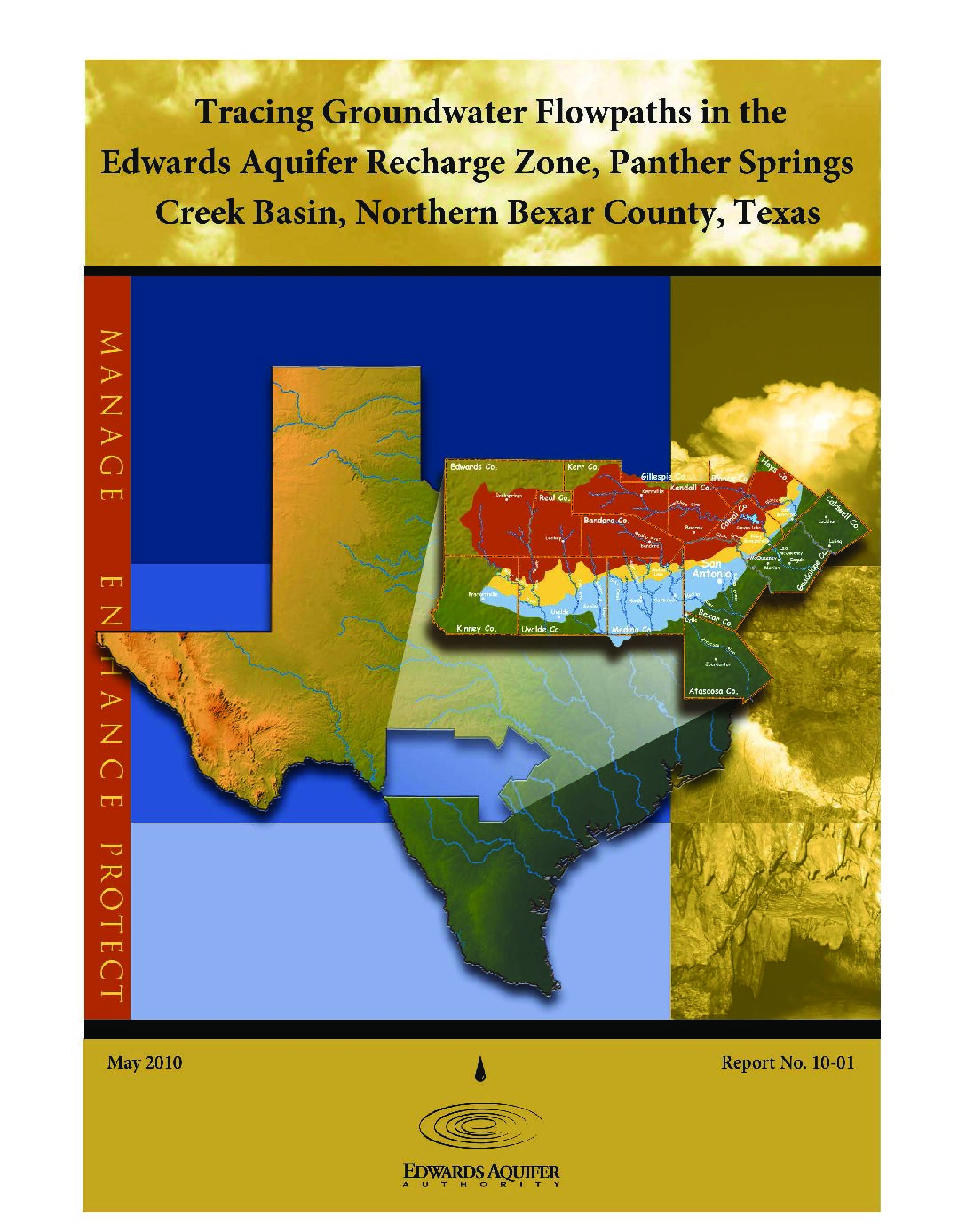
Description: Dye tracer tests in the Edwards Aquifer, Balcones Fault Zone, San Antonio Segment, Bexar County, Panther Springs Creek
Report Number: 1-Oct
Location: Edwards Aquifer, Balcones Fault Zone, San Antonio Segment, Bexar County, Recharge Zone, Artesian Zone,
Summary:The purpose of this study was to characterize groundwater-flow directions and velocities and to evaluate hydrostratigraphy in the Edwards Aquifer recharge zone in northern Bexar County in south-central Texas. It presents the findings of investigations by the Edwards Aquifer Authority regarding groundwater flowpaths, velocities, and hydrostratigraphy in the Panther Springs Creek groundwater basin, which is located in the San Antonio segment of the Balcones Fault Zone Edwards Aquifer. In a series of four phases, the Authority injected nontoxic organic dyes into six caves and sampled an array of 32 wells to track the dye movements. The tracer tests revealed discrete groundwater flowpaths near Panther Springs Creek with apparent (point-to-point) groundwater velocities ranging from 13 to 5,300 meters per day from the recharge zone to the transition/artesian zone of the Edwards Aquifer. The results indicated that groundwater flows freely across faults with displacements up to 104 meters through a single hydrostratigraphic unit comprised of the upper member of the Glen Rose Formation in the Upper Trinity Aquifer and the overlying Edwards Aquifer. Dye poured on the ground surface in an area with no observable karst features such as sinkholes, dissolutioned fractures, or caves demonstrated that the aquifer is vulnerable to contamination even in the absence of recognizable karst landforms.
Records of Precipitation, Aquifer Head, and Ground-Water Recharge to the Edwards and Associated Limestones, San Antonio Area, Texas, 1971

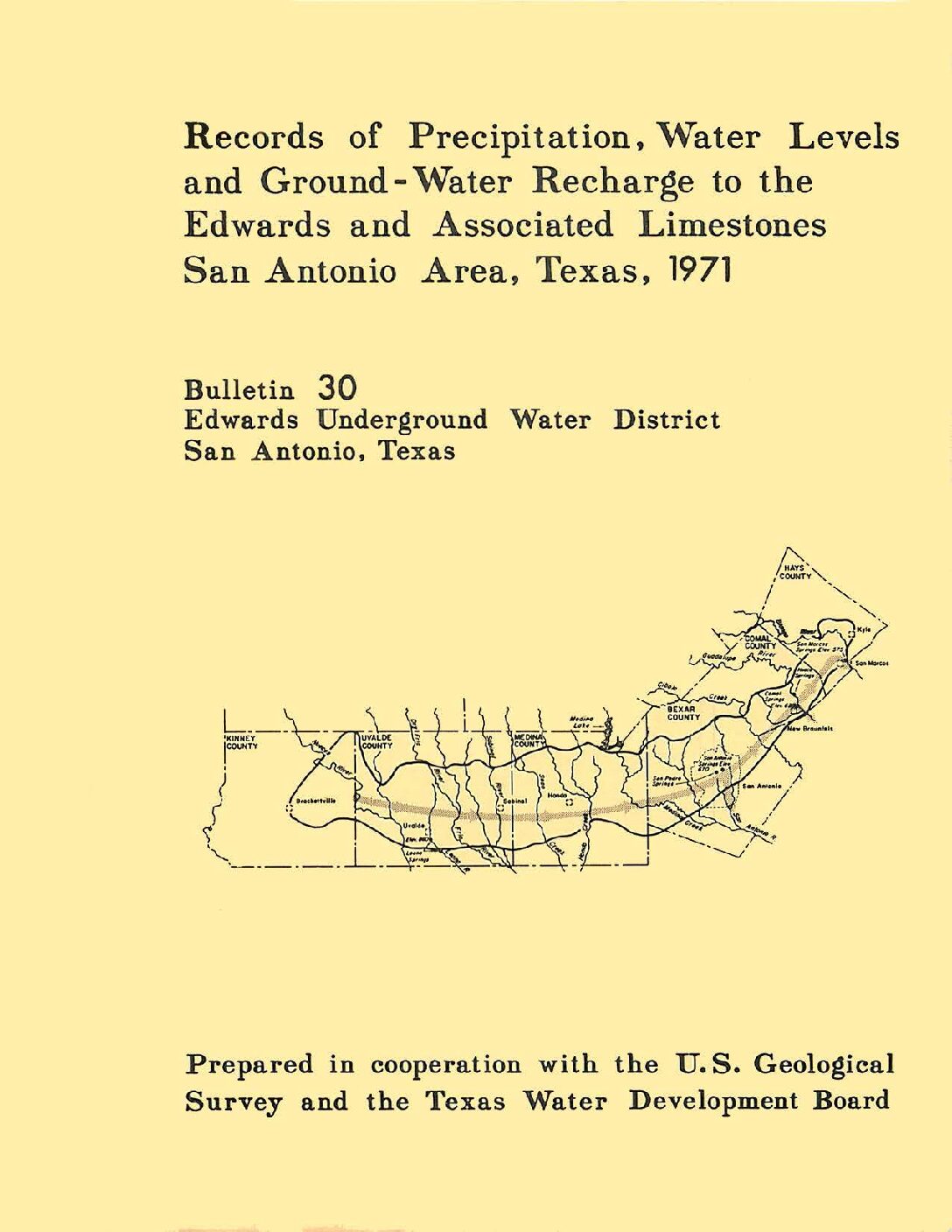
Description: Annual report for 1971 on precipitation, aquifer levels, and recharge to the Edwards Aquifer issued by the Edwards Underground Water District
Report Number: Bulletin 30
Location: Edwards Aquifer - San Antonio Area
Summary:Records of precipitation, water levels, and estimates of recharge to the Edwards and associated limestones in the San Antonio area during 1971 are summarized in this report. The compilation of these basic records is part of a continuing hydrologic investigation by the U.S. Geological Survey in cooperation with the Edwards Underground Water District and the Texas Water Development Board. Previous reports are given in the list of references.
The annual precipitation at selected stations throughout the San Antonio area for 1971 and the annual average for each of these stations are shown in table 1. Rainfall was above average throughout most of the recharge area during 1971.
The recorded high and low water levels in five selected key wells during 1971 are shown in table 2. During the year, the water levels reached a lower point during June than had been experienced for several years; however, toward the latter part of the year, the water levels fluctuated near the record highs. The record highs and lows are also given in table 2. Ground-water storage in the Edwards Limestone remained above average during 1971.
Recharge to the Edwards and associated limestones is chiefly from streams that lose most of their base flow and a part of their flood flow as they cross the Balcones Fault Zone on the outcrop of the aquifer. The recharge is estimated from discharge records at gaging stations located above and below the infiltration areas on most of the streams. The monthly mean discharge at the gaging stations for October-December 1971 is given in table 3. Streamflow records for January-September 1971 will be published by the U. S. Geological Survey in late 1972.
The recharge in each basin of the San Antonio area for 1971 and the average annual recharge for the period 1934-70 are given in table 4. The basic methods employed by Petitt and George (1956) and by Garza (1962) were used for estimating the 1971 recharge. Total recharge in 1971 was in excess of the average annual recharge by nearly 400,000 acre-feet and was about 75 percent above the annual average {see table 4).
Floods resulting from high-intensity rains during August through November provided about 75 percent of the annual recharge, while the remaining recharge was provided by springflow from the Edwards Plateau.
Quality of Stormwater Runoff from an Urbanizing Watershed and a Rangeland Watershed in the Edwards Aquifer Recharge Zone, Bexar and Uvalde Counties, Texas, 1996-98

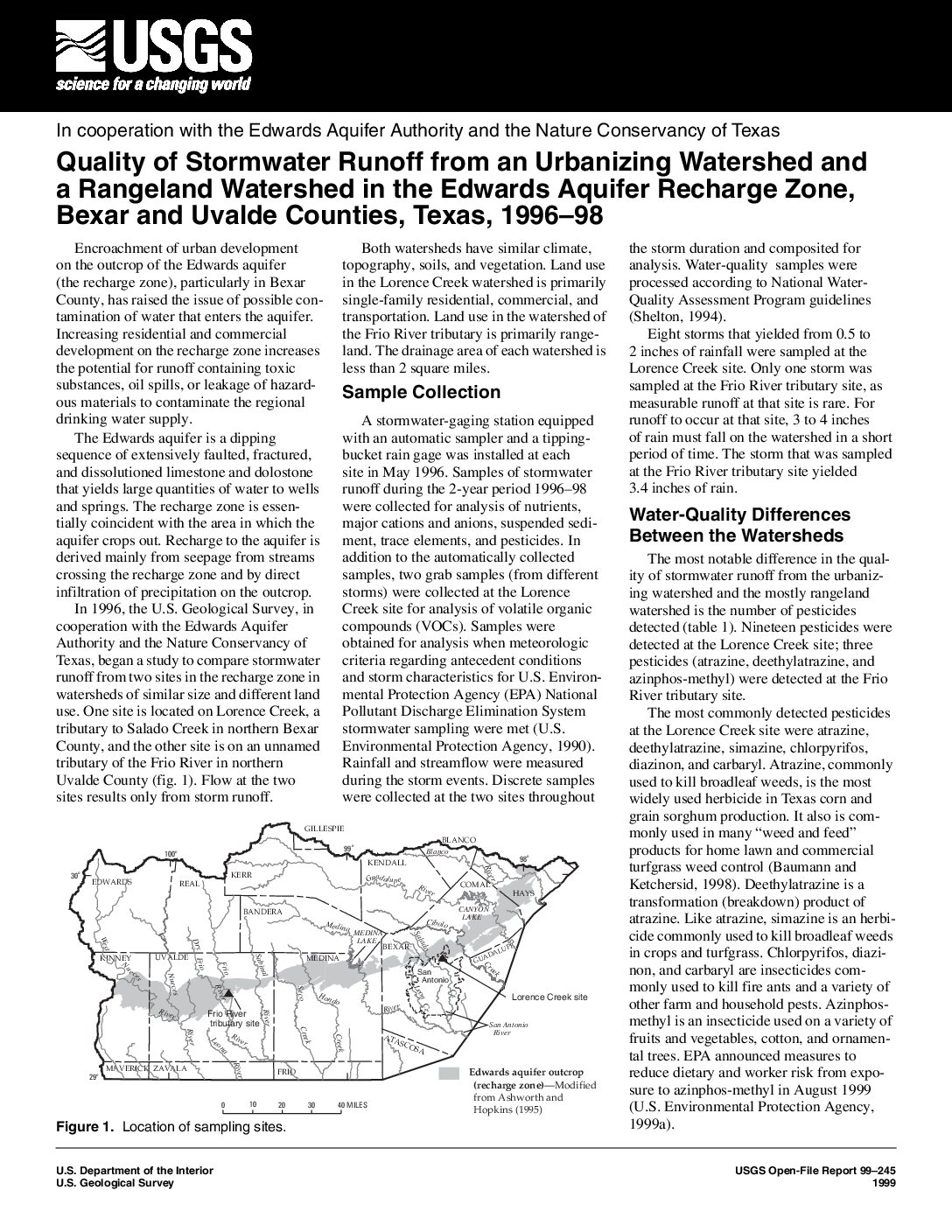
Description: Water quality study on stormwater runoff in an urbanizing vs rural area of the Edwards Aquifer Recharge Zone
Report Number: USGS O-FR 99-245
Location: Edwards Aquifer Recharge Zone, Bexar County, Uvalde County
Summary:In 1996, the U.S. Geological Survey, in cooperation with the Edwards Aquifer Authority and the Nature Conservancy of Texas, began a study to compare stormwater runoff from two sites in the recharge zone in watersheds of similar size and different land use. One site is located on Lorence Creek, a tributary to Salado Creek in northern Bexar County, and the other site is on an unnamed tributary of the Frio River in northern Uvalde County (fig. 1). Flow at the two sites results only from storm runoff. Both watersheds have similar climate, topography, soils, and vegetation. Land use in the Lorence Creek watershed is primarily single-family residential, commercial, and transportation. Land use in the watershed of the Frio River tributary is primarily rangeland. The drainage area of each watershed is less than 2 square miles.
The most notable difference in the quality of stormwater runoff from the urbanizing watershed and the mostly rangeland watershed is the number of pesticides detected (table 1). Nineteen pesticides were detected at the Lorence Creek site; three pesticides (atrazine, deethylatrazine, and azinphos-methyl) were detected at the Frio River tributary site.Six VOCs were detected in the two grab samples collected at the Lorence Creek site. Four of the six VOCs detected (1,2,4-trimethylbenzene, benzene, ethylbenzene, and xylenes) are used as gasoline additives (Lucius and others, 1992). Concentrations of all pesticides and VOCs detected for which EPA has established maximum allowable or recommended concentrations for drinking water were less than those maximums (U.S. Environmental Protection Agency, 1999b).
Evapotranspiration A Method of Disposing of Septic Tank Effluent

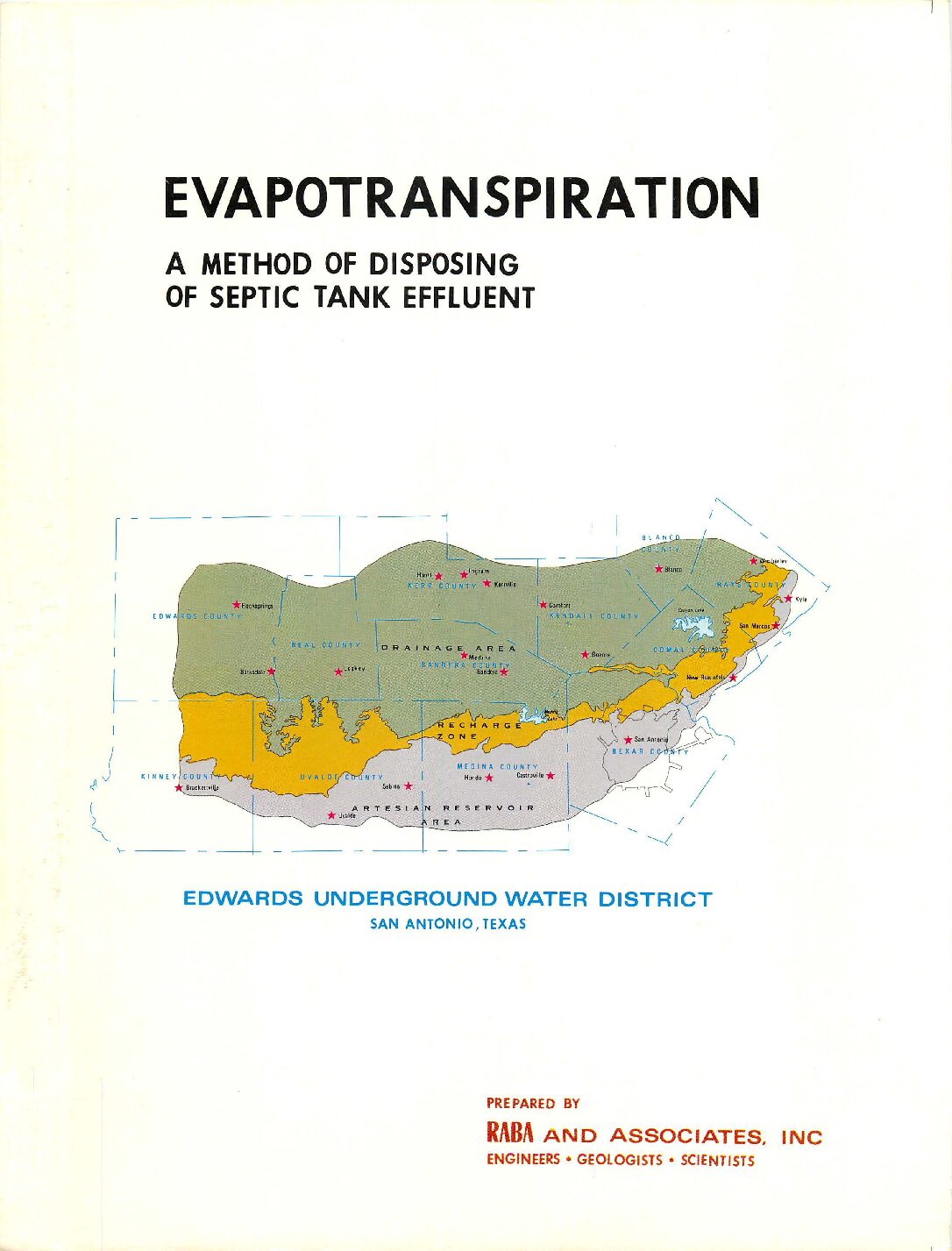
Description: Feasibility study for evapotranspiration as an effective means of disposing septic tank effluent
Report Number: G 75-185
Location: Edwards Aquifer Recharge Zone, Bexar County
Summary:The Edwards Aquifer, an extensive formation of limestone and dolomite extending over a vast portion of central Texas, is the sole source of water for over 1,000,000 people. Its Recharge Zone, encompassing all or parts of some nine counties, is particularly vulnerable to contamination if population growth and property development continues to the north of the metropolitan areas which are on or adjacent to the zone.
While the septic tank-soil absorption system is a valuable and popular method of disposing of domestic household sewage, this and other traditional methods of sewage disposal are not suitable in this instance because of the geology of the Recharge Zone and very thin soil cover.
After an extensive search of the literature, RABA AND ASSOCIATES, CONSULTING ENGINEERS, INC., petitioned the Edwards Underground Water District for its support and funding to develop design criteria for the construction and installation of a viable alternative to the traditional methods of septic tank effluent disposal. This alternative was the evapotranspiration process.
Beginning in July, 1975, and extending over a period of two years, a multi-discipline team of researchers investigated and obtained design parameters at an experimental site located in north Bexar County, Texas, an area which is a part of the Recharge Zone. While it was known that investigations had been made of evapotranspiration by others, the majority of this prior research was directed toward studying water loss via this process but with an eye to conserving water. This project was designed to study the opposite view. Here, by encouraging water loss from a set of test tanks, insight was gained into means of utilizing this loss to remove fluid wastes deposited in the system from a septic tank.
The principle. conclusion drawn from this study is that evapotranspiration is a viable alternative to traditional methods of sewage disposal in areas of very low permeability or areas with extremely high permeability in which underground aquifers may be endangered. The design criteria sought have been established although more study is needed to refine and improve certain aspects of the procedure. As a result of the present work, it is now possible to determine with reasonable accuracy the surface area needed to permit the installation and proper functioning of an evapotranspiration system.
Edwards Aquifer Authority Well Plugging and Abandonment Study

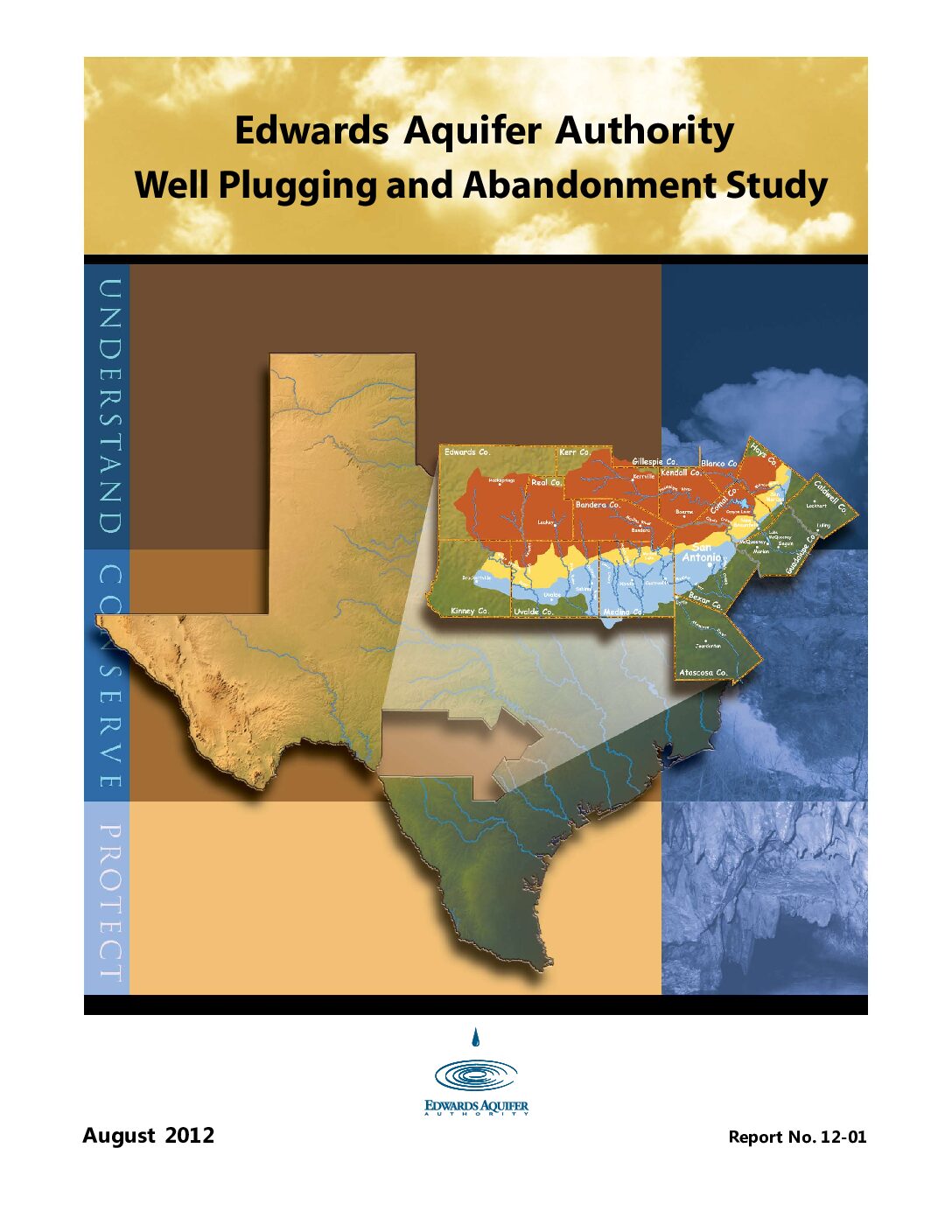
Description: Geophysical tests on an abandoned well to determine best method of achieving sealing of the annular space
Report Number: 1-Dec
Location: Bexar County
Summary:EAA regulations require plugging of abandoned wells, including either removal of existing casing or perforation of the well casing and subsequent sealing of the annular space. Prior to implementation of EAA regulations, wells were commonly abandoned by filling of the well bore and casing with cement or grout and ignoring the annular space. Poor sealing of the annular space of wells, either during drilling or plugging, has the potential to contribute to groundwater contamination.
This study was developed to evaluate the effectiveness of current well-plugging methodology required in the EAA's rules when applied to Edwards Aquifer wells. The study involved:
*Applying a suite of geophysical logging tools to an Edwards Aquifer well before plugging to identify depths at which little or no annular seal was present.
*Subsequent perforation of well casing at selected depths with perforation intervals on the basis of results of geophysical logging.
*Sealing of well bore and annular space, redrilling of well bore, relogging of well to ascertain quality of cement seal, and final abandonment of the well.
Geophysical tools, including a three-arm caliper, natural gamma, DHC, FWS, and nuclear (compensated gamma“gamma density and neutron) tools, were used to evaluate the effectiveness of current well-plugging practices for the protection of water quality. The caliper, the DHC, and the natural gamma tools provided an assessment of the inside condition of the casing, but they were unable to evaluate the condition of the annular space between the outside of the casing and geologic formations. The FWS tool may provide some insight into the annular seal of a well; however, it does not appear to have the resolution or reliability of the nuclear tools.
The compensated gamma“gamma density and neutron source tools provided a means of evaluating the condition of the annular seal, as well as a delineation of voids in the annular space. Additionally, the CDL seemed to be more useful in void detection in the annular space, requiring both compensated gamma“gamma density and neutron source tools to get the job done. These tools can be used within or above the water table without impact to log quality or diagnostic capabilities.
W104-265 (Car Lot Well) was selected for this study because it offered a larger diameter casing (six inches) and a longer casing than other wells that have been examined. Perforation points were chosen on the basis of distinctive qualities of the annular seal, as determined from nuclear logs. Two of the perforation locations were selected at intervals in which the annular seal was evaluated as good, and three perforation locations were selected at intervals in which the annular seal was evaluated as poor to nonexistent. The intervals 42 to 88 and 125 to 185 ft are locations at which a good annular seal was suggested. Intervals from 28 to 42, 192 to 222, and 232 to 289 ft were evaluated and estimated to contain 50 to 100% void space. So that the effect of perforations on casing with good annular seal versus casing with 50% or greater void space in the annulus could be compared, perforations were made in both areas. Perforation depths of 53 and 135 ft bgs were selected for good annular seal tests, whereas perforations at 30, 193, and 271 ft bgs were selected to test areas with 50% or greater annular void space. Clean, round holes were formed by shaped explosive charges where solid annular material occurred between the casing and the borehole wall. Casing cracked or split in intervals where little or no material occurred in the annular space. Analysis of nuclear logs indicates that plugging of the annular void area through the perforations was highly successful. Postperforation and cementing source logging indicated that a good seal was achieved in areas previously indicating 50% or greater void space, and no significant change was noted for the two areas that indicated a good annular seal.
This study showed that grouting of the well using gravity-fed tremmie methods from the bottom to the top provided pressure sufficient to force cement through the perforations in the well casing, creating an adequate annular seal. Decreasing the explosive-charge interval from 50 to 25 ft would increase the likelihood of intersecting an annular void.
Records of Precipitation, Aquifer Head, and Ground-Water Recharge to the Edwards and Associated Limestones, San Antonio Area, Texas, 1972-73

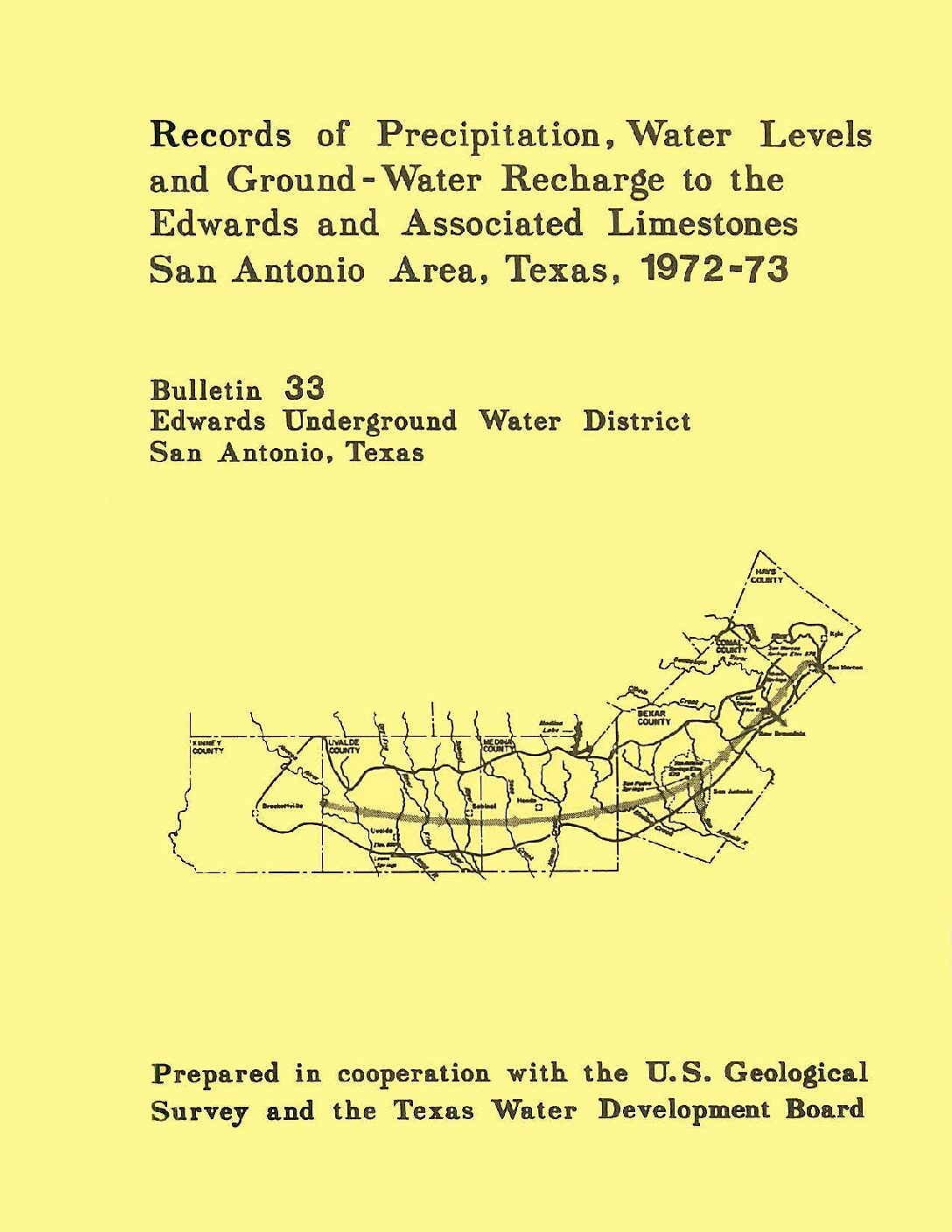
Description: Annual report for 1972-73 on precipitation, aquifer levels, and recharge to the Edwards Aquifer issued by the Edwards Underground Water District
Report Number: Bulletin 33
Location: Edwards Aquifer Balcones Fault Zone San Antonio Segment
Summary:Records of precipitation, water levels, and estimates of recharge to the Edwards and associated limestones in the San Antonio area during 1972-73 are summarized in this report.
Rainfall for 1972 was near average at most of the stations in the San Antonio area. During 1973, a new annual rainfall record of 52.28 inches was recorded at the San Antonio station, and rainfall was well above average at selected stations throughout the area.
Ground-water storage in the Edwards and associated limestones was well above average during 1972-73.
Recharge in 1972 and 1973 was in excess of the average annual recharge. During 1973, the recharge was in excess of the average annual recharge by nearly 955,000 acre-feet, or about 180 percent of the annual average.
Quantity and Quality of Low Flow in the Hondo Creek Basin, Texas March 27-28, 1968

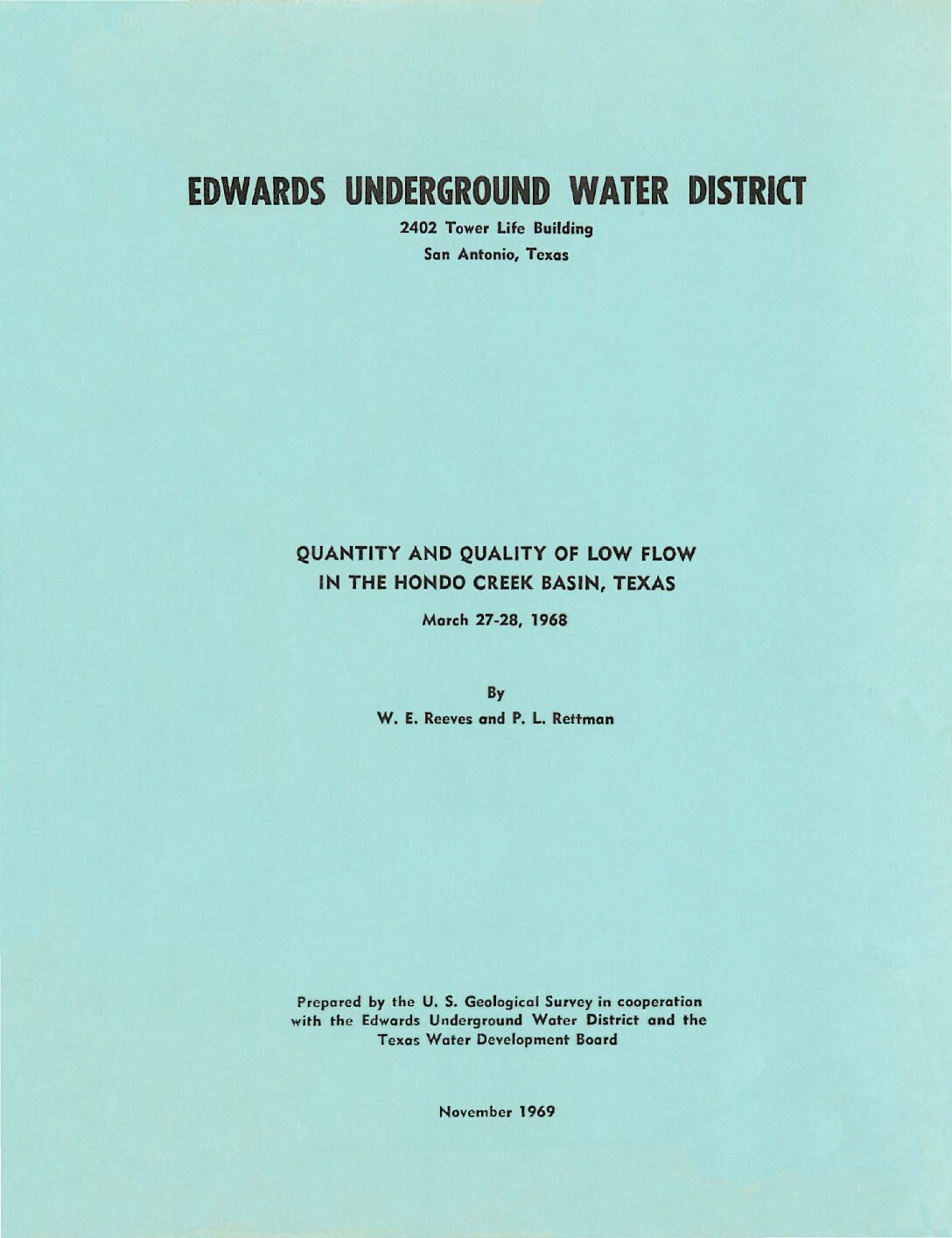
Description: Low-flow study of Hondo Creek Basin, TX March 27-28, 1968
Location: Hondo Creek Basin
Summary:This investigation was made to determine the changes in quantity and quality of low flow in the reach of Hondo Creek that contributes recharge to the Edwards and associated limestones.
A determination of the gains and losses in a 29.5-mile reach of Hondo Creek near Hondo, Texas, was made on March 27-28, 1968. A net loss of 106 cfs (cubic feet per second) occurred in the reach (site 2 to site 8) that contributes recharge to the Edwards and associated limestones. These losses were greater than those that occurred during the previous low-flow investigation in April 1958. The quality of water showed a general improvement downstream except for sites on and downstream from Verde Creek.
Records of Precipitation, Aquifer Head, and Ground-Water Recharge to the Edwards and Associated Limestones, San Antonio Area, Texas, 1970


Description: Annual report for 1970 on precipitation, aquifer levels, and recharge to the Edwards Aquifer issued by the Edwards Underground Water District
Report Number: Bulletin 27
Location: Edwards Aquifer Balcones Fault Zone San Antonio Segment
Summary:Records of precipitation, water levels, and estimates of recharge to the Edwards and associated limestones in the San Antonio area during 1970 are summarized in this report.
Rainfall for 1970 was below average throughout most of the recharge area. The water levels fluctuated just below the record high, owing to recharge from high flood runoff during intense storms. Groundwater storage in the Edwards Limestone remained above average during 1970. The estimated recharge was 661,600 acre-feet, which is about 30 percent above the average recharge for the period 1934-69.
Records of Precipitation, Aquifer Head, and Ground-Water Recharge to the Edwards and Associated Limestones, San Antonio Area, Texas, 1969

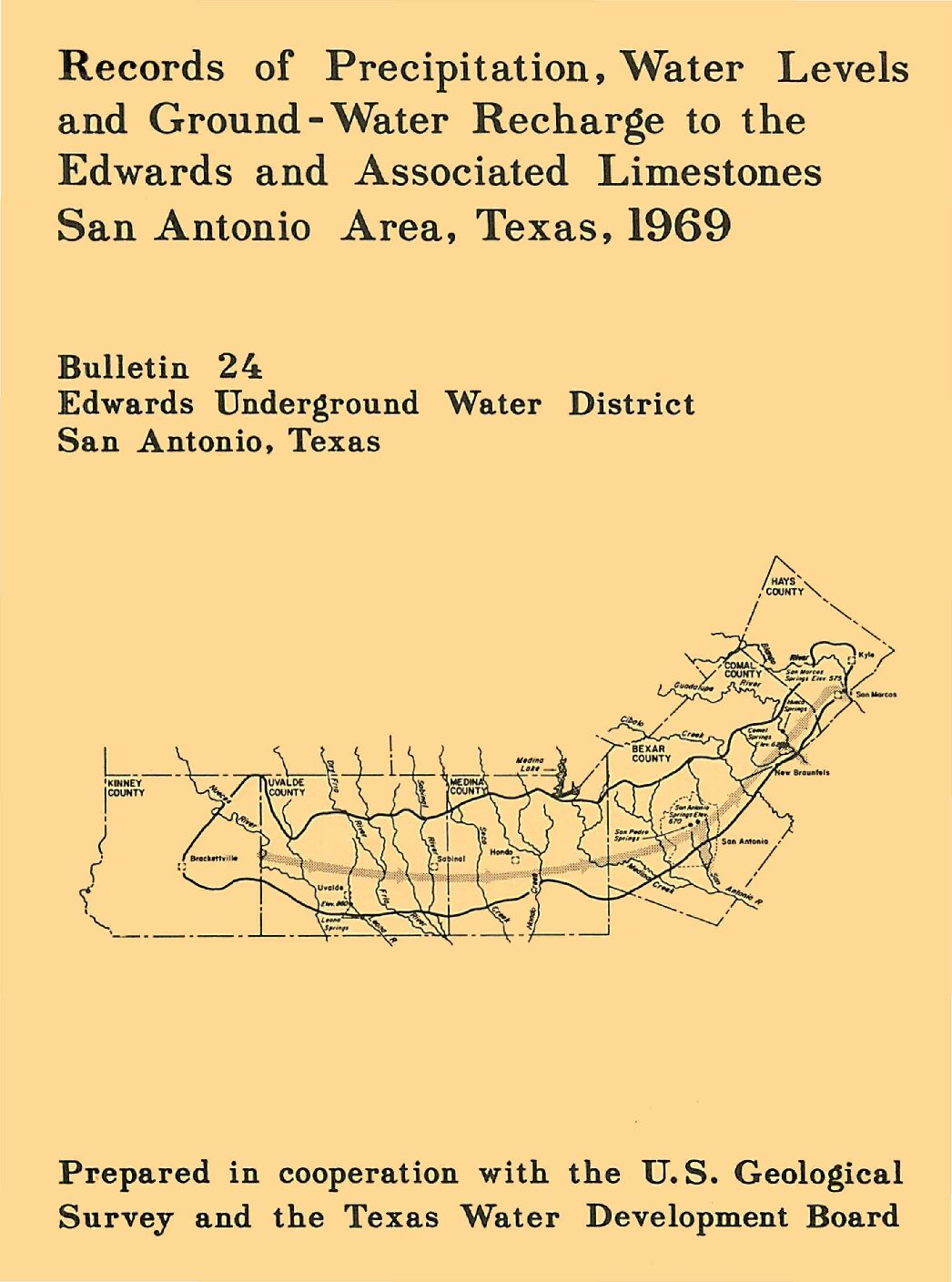
Description: Annual report for 1969 on precipitation, aquifer levels, and recharge to the Edwards Aquifer issued by the Edwards Underground Water District
Report Number: Bulletin 24
Location: Edwards Aquifer Balcones Fault Zone San Antonio Segment
Summary:Records of precipitation, water levels, and estimates of recharge to the Edwards and associated limestones in the San Antonio area during 1969 are summarized in this report. The compilation of these basic records is part of a continuing hydrologic investigation by the U. S. Geological Survey in cooperation with the Edwards Underground Water District and the Texas Water Development Board. Previous reports are given in the list of references.
The annual precipitation at selected stations throughout the San Antonio area for 1969 and the annual average for each of these stations are shown in table 1. Rainfall was above average throughout the recharge area during 1969.
The recorded high and low water levels in five selected key wells during 1969 are shown in table 2. During the year, the water levels fluctuated just below the record high. The record highs and lows are also given in table 2. Ground-water storage in the Edwards limestone was above average during 1969.
Recharge to the Edwards and associated limestones is chiefly from streams that lose most of their base blow and a part of their flood flow as they cross the Balcones Fault Zone on the outcrop of the aquifer. The recharge is estimated from discharge records at gaging stations located above and below the infiltration areas on most of the streams. The monthly mean discharge at the gaging stations for October-December 1969 is given in table 3. Streamflow records for JanuarySeptember 1969 will be published by the U.S. Geological Survey in late 1970.
The recharge in each basin of the San Antonio area for 1969 and the average annual recharge for the period 1934-68 are given in table 4. The basic methods employed by Petitt and George (1956) and by Garza (1962) were used for estimating the 1969 recharge.
Springflow from the Edwards Plateau was the main source of recharge during the first nine months of 1969, while floods during the last three months furnished the main source of recharge. The total recharge was about 10 percent above the average annual (see table 4).
Records of Precipitation, Aquifer Head, and Ground-Water Recharge to the Edwards and Associated Limestones, San Antonio Area, Texas, 1968

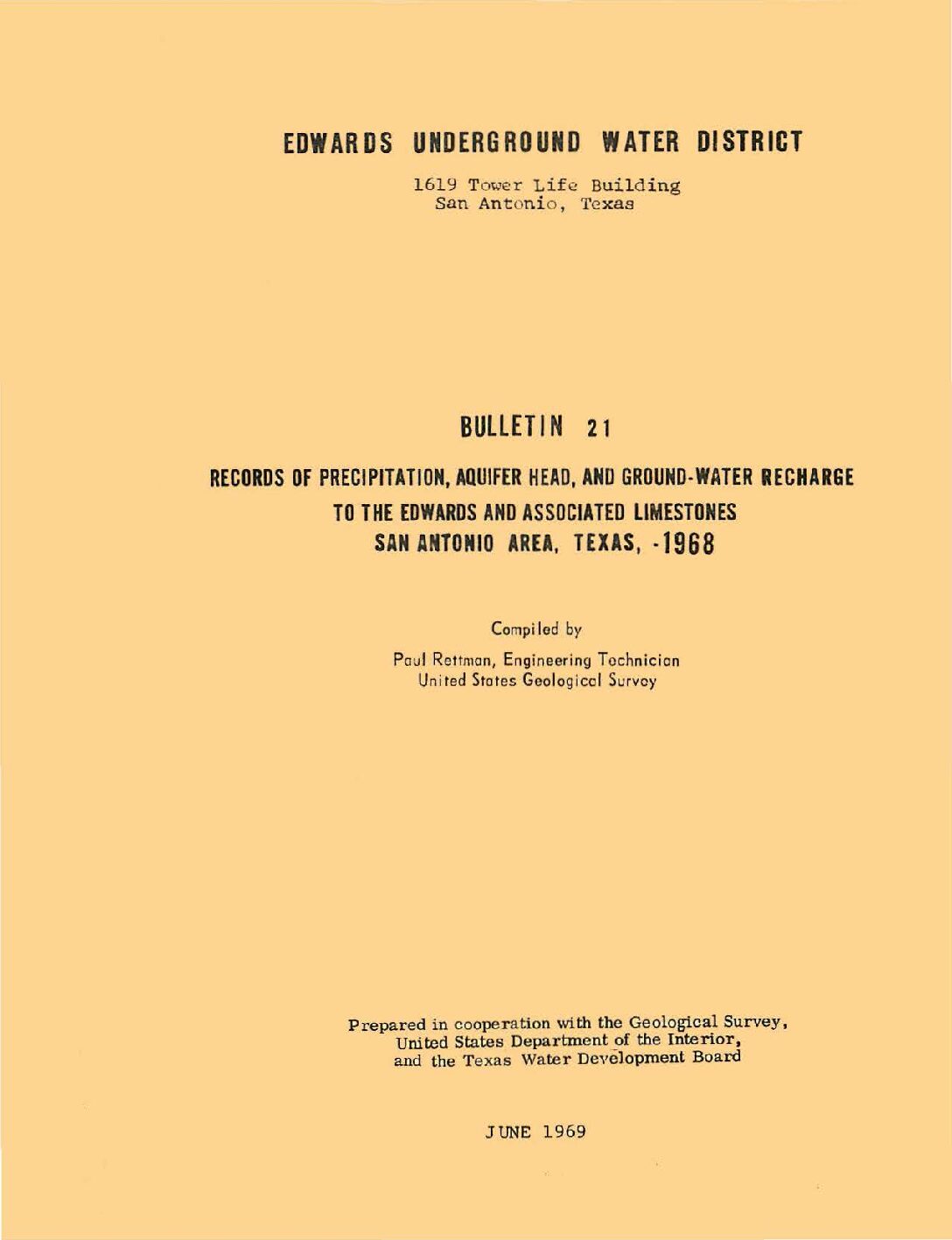
Description: Annual report for 1968 on precipitation, aquifer levels, and recharge to the Edwards Aquifer issued by the Edwards Underground Water District
Report Number: Bulletin 21
Location: Edwards Aquifer Balcones Fault Zone San Antonio Segment
Summary:The Edwards and associated limestones, the principal aquifer in the San Antonio area, has been the subject of numerous geologic and hydrologic reports. Records of precipitation, water levels, and estimates of recharge to the aquifer during 1967 are summarized in this report, which is part of the basic-data collection published by the Edwards Underground Water District. The compilation of these basic records (and data} is part of the continuing hydrologic investigation by the Uo S. Geological Survey in cooperation with the Edwards Underground Water District and the Texas Water Development Board.
The annual precipitation at selected stations throughout the San Antonio area for 1967 and the annual average for each of these stations are shown in table 1. Rainfall was generally deficient for the first eight months of 1967 and excessive during the remainder of the year.
The recorded high and low water levels in five selected key wells during 1967 are shown in table 2. During the year, the water levels fluctuated near the midpoint between the record high and low levels which are also shown in table 2. Ground water storage and water levels in the Edwards limestone reached a lower point during August than had been experienced for several years.
Recharge to the Edwards and associated limestones is chiefly from streams which lose most of their base flow and a part of their floodflow as they cross the Balcones fault zone on the outcrop of the aquifer. The recharge is estimated from discharge records at gaging stations located above and below the infiltration areas on most of the streams. The monthly mean discharge at the gaging stations for October-December 1967 are shown in table 3. Streamflow records for January-September 1967 are being published by the U. S. Geological Survey (U. s. Department of the Interior, 1967).
The recharge in each basin of the San Antonio area for 1967 and the average annual recharge for the period 1934-66 are shown in table 4. The basic methods employed by Petitt and George (1956) and by Garza (1962) were used for estimating the 1967 recharge, which was below the average annual. In September 1967, the deficient rainfall pattern was broken by the rains that accompanied Hurricane Beulah. Seventy-five percent of the total recharge for 1967 occurred during the last four months of the year.
Evaluation of the Option to Designate a Separate San Marcos Pool for Critical Period Management

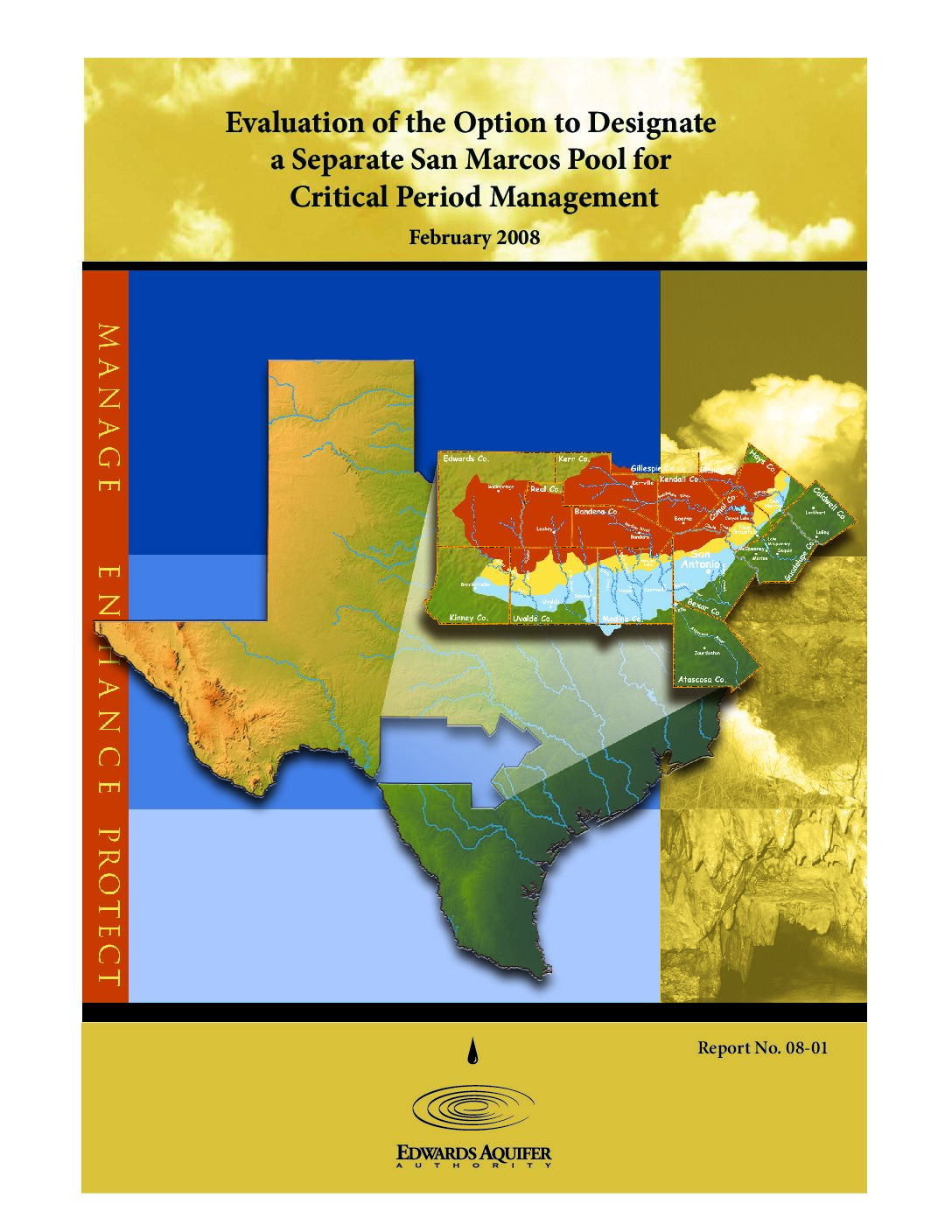
Description: Hydrogeologic relationships between nearby streams and rivers to springflow at San Marcos Springs
Report Number: 1-Aug
Location: San Marcos Springs
Summary:This report presents the findings of the Edwards Aquifer Authority's investigation into the hydrogeology and hydrodynamics of water discharging from San Marcos Springs in Hays County, Texas. The purpose of the report is to determine whether there is sufficient technical justification for distinct aquifer management rules for the designation of a San Marcos Pool in the San Marcos area regarding critical period management. Historical records indicate that Comal Springs and San Marcos Springs respond differently to rainfall, which could indicate that these springs represent separate hydrologic subbasins or pools within the San Antonio Segment of the Balcones Fault Zone Edwards Aquifer. The report concludes that water for both San Marcos Springs and Comal Springs is derived from the western portion of the aquifer. Groundwater flows through the Artesian fault block and either discharges from Comal Springs or bypasses Comal Springs and discharges at San Marcos Springs. At higher discharge rates, San Marcos Springs is also recharged by water infiltrating from Cibolo Creek, the Guadalupe River, Dry Comal Creek, Sink Creek, and other streams, especially when a groundwater mound forms under Onion Creek. Despite the large volume of water that these streams carry at times, they contribute relatively small amounts to San Marcos springflow. The report concludes that there is not sufficient technical justification at this time to create a separate San Marcos Pool and recommends that an index well be established in the San Marcos area for triggering critical period levels. The report was prepared by Authority staff in February 2008.
Records of Precipitation, Aquifer Head, and Ground-Water Recharge to the Edwards and Associated Limestones, San Antonio Area, Texas, 1967

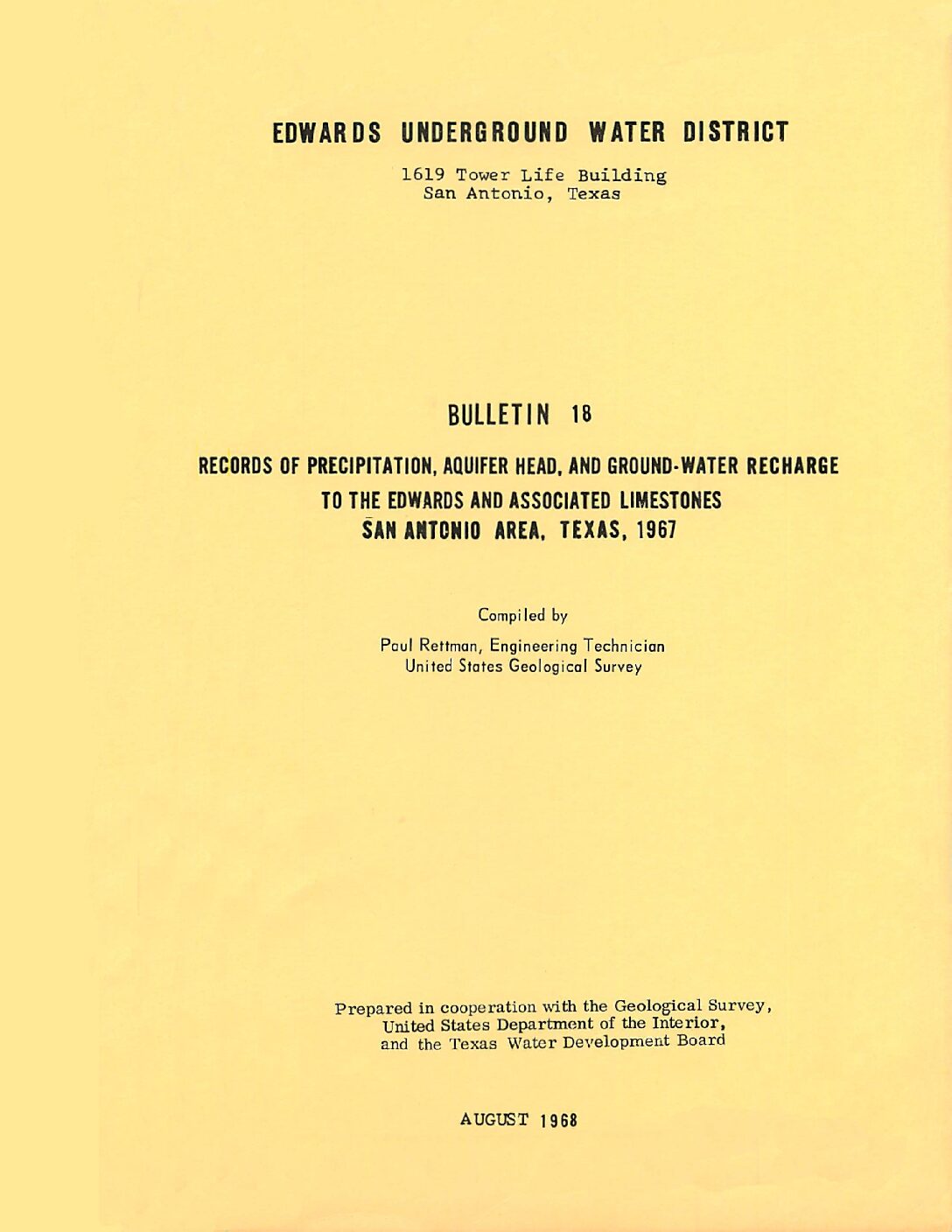
Description: Annual report for 1967 on precipitation, aquifer levels, and recharge to the Edwards Aquifer issued by the Edwards Underground Water District
Report Number: Bulletin 18
Location: Edwards Aquifer Balcones Fault Zone San Antonio Segment
Summary:The Edwards and associated limestones, the principal aquifer in the San Antonio area, has been the subject of numerous geologic and hydrologic reports. Records of precipitation, water levels, and estimates of recharge to the aquifer during 1967 are summarized in this report, which is part of the basic-data collection published by the Edwards Underground Water District. The compilation of these basic records (and data} is part of the continuing hydrologic investigation by the Uo S. Geological Survey in cooperation with the Edwards Underground Water District and the Texas Water Development Board.
The annual precipitation at selected stations throughout the San Antonio area for 1967 and the annual average for each of these stations are shown in table 1. Rainfall was generally deficient for the first eight months of 1967 and excessive during the remainder of the year.
The recorded high and low water levels in five selected key wells during 1967 are shown in table 2. During the year, the water levels fluctuated near the midpoint between the record high and low levels which are also shown in table 2. Ground water storage and water levels in the Edwards limestone reached a lower point during August than had been experienced for several years.
Recharge to the Edwards and associated limestones is chiefly from streams which lose most of their base flow and a part of their floodflow as they cross the Balcones fault zone on the outcrop of the aquifer. The recharge is estimated from discharge records at gaging stations located above and below the infiltration areas on most of the streams. The monthly mean discharge at the gaging stations for October-December 1967 are shown in table 3. Streamflow records for January-September 1967 are being published by the U. S. Geological Survey (U. s. Department of the Interior, 1967).
The recharge in each basin of the San Antonio area for 1967 and the average annual recharge for the period 1934-66 are shown in table 4. The basic methods employed by Petitt and George (1956) and by Garza (1962) were used for estimating the 1967 recharge, which was below the average annual. In September 1967, the deficient rainfall pattern was broken by the rains that accompanied Hurricane Beulah. Seventy-five percent of the total recharge for 1967 occurred during the last four months of the year.
Records of Precipitation, Aquifer Head, and Ground-Water Recharge to the Edwards and Associated Limestones, San Antonio Area, Texas, 1966


Description: Annual report for 1966 on precipitation, aquifer levels, and recharge to the Edwards Aquifer issued by the Edwards Underground Water District
Report Number: Bulletin 15
Location: Edwards Aquifer Balcones Fault Zone San Antonio Segment
Summary:The Edwards and associated limestones, the principal aquifer in the San Antonio area, has been the subject of numerous geologic and hydrologic reports. Records of precipitation, water levels, and estimates of recharge to the aquifer during 1966 are summarized in this report, which is one of three basic-data reports published yearly by the Edwards Underground Water District. The gathering of these records (and data) is part of the continuing hydrologic investigation by the U.S. Geological Survey in cooperation with the Edwards Underground Water District, the Texas Water Development Board, and the city of San Antonio.
Table 1 shows the annual precipitation at selected stations throughout the San Antonio area for 1966 and the annual average for each of these stations. Most of the area stations for 1966 show rainfall to be below the long-term mean.
The recorded high and low water levels during 1966 in five selected key wells are shown in table 2. In 1966, the water levels fluctuated near or above the midpoint between the record high and low levels which are also shown in table 2. Ground water storage in the Edwards Limestone remained high, although rainfall in 1966 was below average.
Recharge to the Edwards and associated limestones is chiefly from streams which lose most of their base flow and a part of their flood flow as they cross the Balcones fault zone on the outcrop of the aquifer. The recharge is estimated from records of continuous discharge at gaging stations located above and below the infiltration areas in each of most of the streams. The monthly mean discharges at the gaging stations during October-December 1966 are shown in table 3. Streamflow records for January-September 1966 have been published by the U. S. Geological Survey (U. S. Department of the Interior, Geological Survey, Water Resources Division, 1966).
Table 4 shows the recharge in each basin of the San Antonio area for 1966 and the average annual recharge for the period 1934-65. The basic methods employed by Petitt and George (1956) and by Garza (1962) were used for estimating the 1966 recharge, which was well above the annual average. On August 13, 1966, greater than 10 inches of rain fell in the upper watersheds of the Nueces and Frio Rivers. This was followed by moderate rains during September. Recharge from the Nueces and Frio Rivers during August and September was 180 thousand acre-feet or 30 percent of all recharge for 1966. During these two months, the Nueces and Frio Rivers discharged 110 thousand acre-feet past the recharge area due to the high rainfall intensity.
Tracer Test Work Plan, Kinney and Uvalde Counties

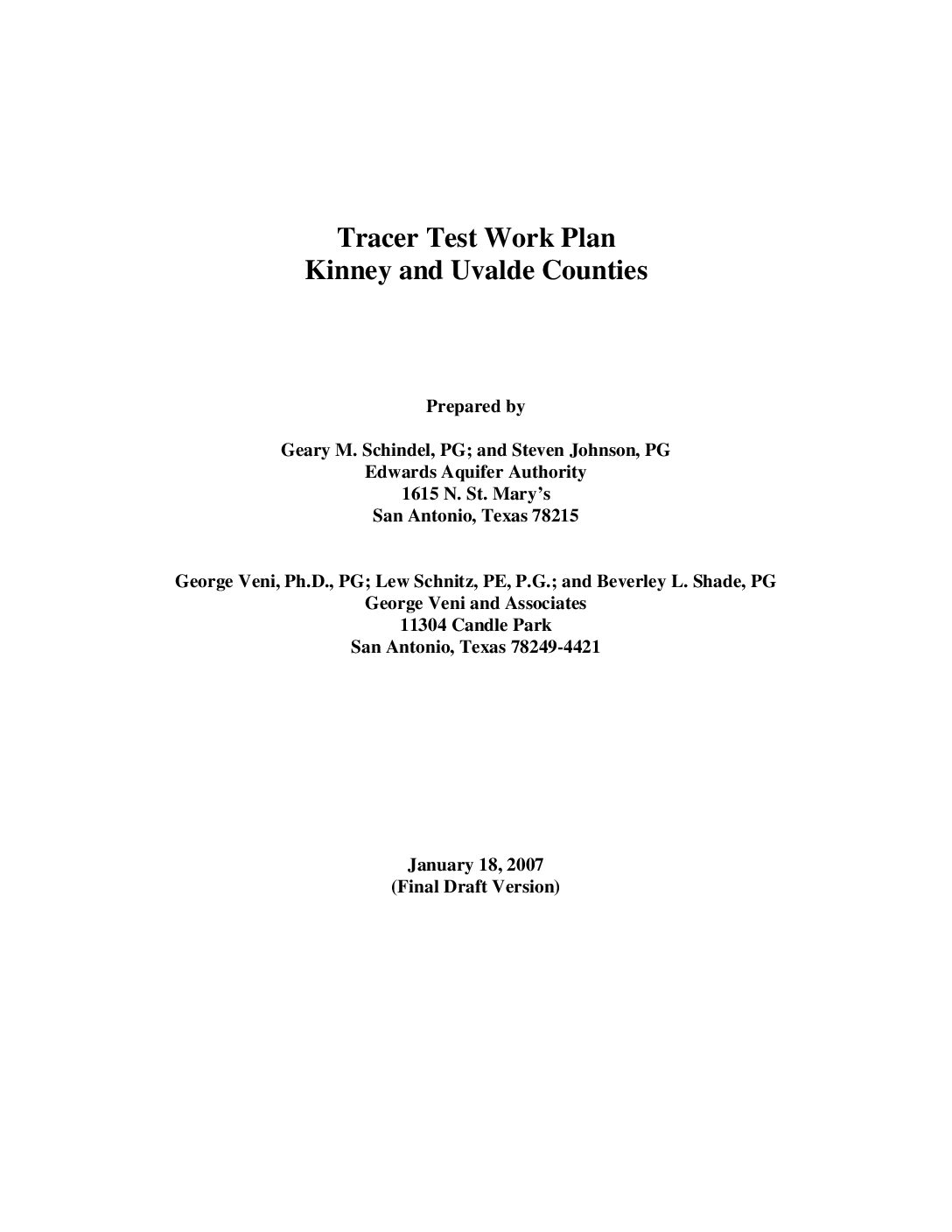
Description: Plan for dye tracer studies in Kinney and Uvalde Counties
Location: Edwards Aquifer, Balcones Fault Zone, San Antonio Segment, Kinney County, Uvalde County, Recharge Zone, Artesian Zone
Summary:This Work Plan was prepared by Authority staff and defines the scope of work and the methodology that will be followed during tracer testing in Kinney and Uvalde counties.
Groundwater movement in the Edwards Aquifer has been characterized primarily by well data, potentiometric surface mapping, and computer modeling. While each of these techniques provides useful information, tracer testing has long been demonstrated as one of the most effective tools in quantifying groundwater movement in karst aquifers. Tracer testing provides empirical data on groundwater behavior that can be used to delineate drainage basins, identify groundwater flowpaths, and measure groundwater velocities, dilution, dispersion, and storage. The results are far more meaningful and accurate when compared to similar results produced by computer groundwater modeling.
The focus of this test is to investigate the sources of water for the principal springs in Kinney and Uvalde counties. Included in the study will be Pinto, Mud, and Las Moras springs in Kinney County and Leona Springs in Uvalde County. This test will be conducted under the auspices of the Edwards Aquifer Authority (Authority) and its contractor, George Veni and Associates.
This work plan describes the procedures that the Authority typically implements for tracer tests in the Edwards Aquifer. It is based on the Authority's knowledge of the groundwater conditions and the objective of obtaining scientifically valid results. Each activity within the work plan is affected by the results of the preceding work. For example, the results of the initial tracer injections will form the basis for planning subsequent injections. Consequently, some activities described in this work plan may be changed or omitted during the course of the tracer test. The Authority will prepare a report at the conclusion of the test to describe the actual methodology and findings.
The report by Green and Others (2006) on groundwater resources in Uvalde and Kinney counties recommended a series of tracer tests to test the conclusions in the report. The objective of this tracer test study is to test the conclusions of the SWRI study by:
- Evaluating the groundwater flowpaths in the Kinney/Uvalde County area.
- Evaluating the hydraulic characteristics of the Edwards Aquifer.
This work plan outlines a tracer test methodology for evaluation of the time-of-travel, direction, and destination of groundwater movement in a portion of the Kinney and Uvalde portions of Edwards Aquifer recharge and artesian zones. This section outlines the tasks and strategy to be implemented.
Appendix A provides the project quality assurance and quality control (QA/QC) sampling protocols, as prepared by the Authority. Appendix B is a glossary of terms for this work plan. Appendix C is a conversion index from the International System of Units used in this report, to English units. Appendix D is a legend of cave map symbols.
Review of Hydrocarbon Transmission Lines Crossing the Edwards Underground Reservoir

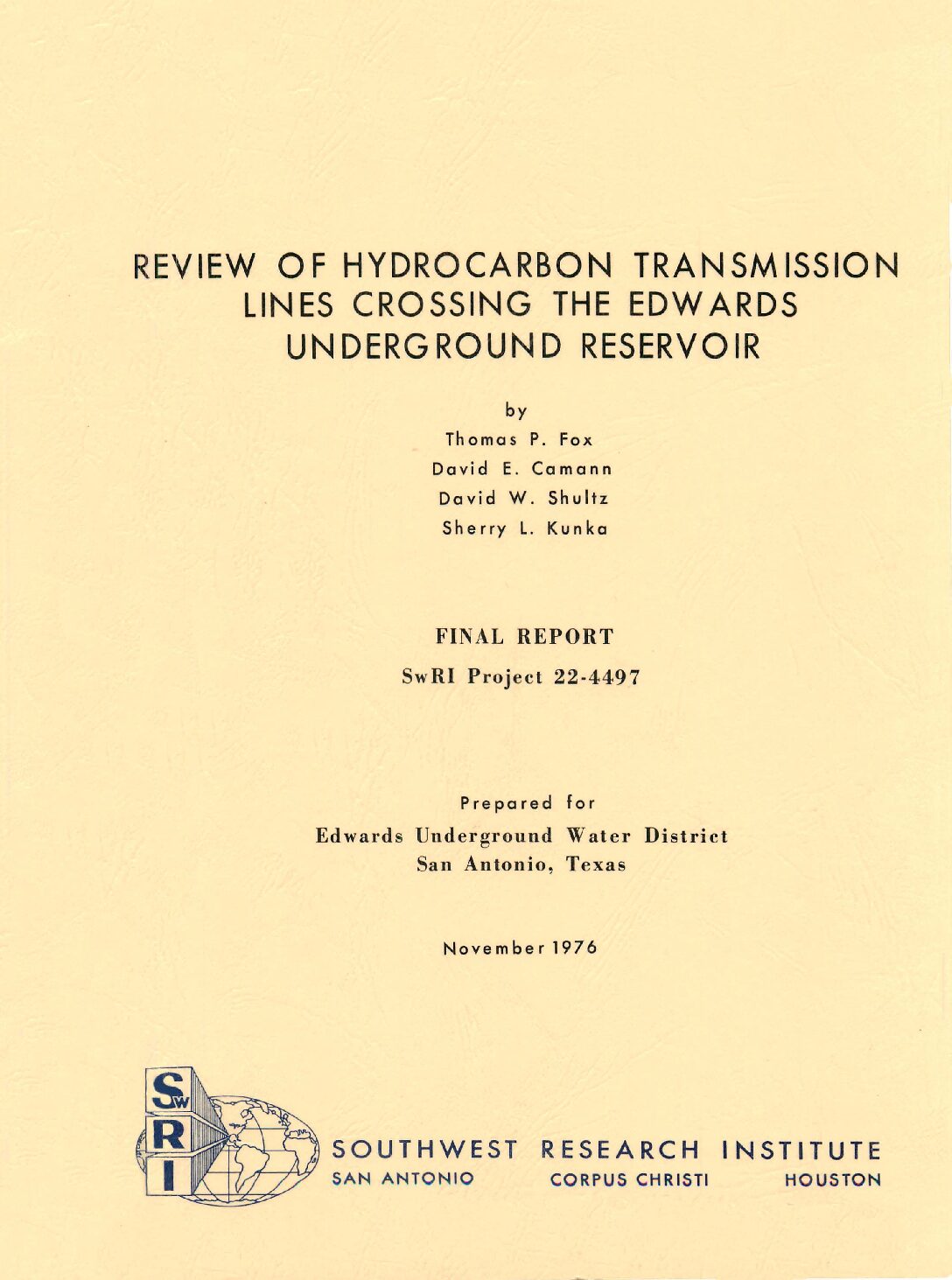
Description: Risk assessment on the likelihood of leaks from oil pipelines over the Edwards Aquifer
Location: Edwards Aquifer - General
Summary:Although little information has been reported on contamination of groundwater from crude oil trunk pipelines, the significance of these pipelines cannot be minimized. Hydrocarbon transmission lines are of primary importance in the consideration of contamination potential. Four of these main trunk lines cross the Edwards Underground Reservoir (EUR) for a total length of 237 miles. These lines cross drainage basins which provide an estimated annual recharge of 20 percent to the total Edwards Aquifer. Limestone aquifers such as the Edwards afford little or no filtration capability to protect groundwater from hydrocarbon transmission line leaks or spills.
After surveying past experience associated with pipeline leaks, it was decided that the U.S. experience was an inadequate data base for predictive analysis; a review of Texas pipeline-related data provided a more adequate source of comparison. There have been nine reported leaks in the EUR from 1970 to the present (September 1976) with corrosion being the primary cause of such leaks. The total reported leaks in Texas from 1973 to 1975 were 1320; of these, 1008 were the result of crude oil pipeline corrosion. Pipelines crossing the EUR have experienced a significantly lower rate of leaks than pipelines over the rest of Texas. The EUR rate is less than 12 percent of the total Texas rate, and too few EUR leaks have occurred to indicate differences in causal factors of these failures. The 1975 Texas failure rate was determined to be 49.79 leaks/ 1000 miles/year while the EUR rate was determined to be 6.33 leaks/ 1000 miles/year. (A lognormal distribution provided the best model for the gross loss spill volume obtained from the total Texas data.)
Further study and assessment produced these additional conclusions concerning future hydrocarbon transmission line leaks:
( l) Using the pessimistic Texas rate assumption, there is a near certainty of at least one oil leak over the EUR each year. By using the EUR rate, there is a 77-percent chance of one or more leaks occurring in a year; thus, it is likely that one or more leaks will continue to occur over the EUR in most years.
(2) For both the U.S. and Texas crude oil pipeline leak experience, there is a trend of decreasing accidents in recent years.
(3) Using the Texas rate assumption, the largest leak over the EUR is likely (about a 61-percent probability) to be between 100 and 499 barrels for a 1-year period. Using the EUR rate, the largest spill is expected to be less than 100 barrels (69-percent probability) for the same time period.
( 4) Using the Texas rate assumption, there is a high probability of the cumulative spill volume exceeding 1000 barrels for a time period of several years. The EUR rate indicates that the possibility of such a large spill volume is not too great for time periods of less than I 0 years.
(5) Assuming that the EUR leak rate remains at its recent level (not considering the apparent
trend in decreasing leak numbers), a sizable volume (2501to 6500 barrels) of crude oil is likely to be spilled over the EUR over a 20-year period.
( 6) The probability of a single leak greater than 10,000 barrels is negligible (0.1 percent) even for a 20-year time period using the EUR failure rate.
(7) The predicted impact of small leaks (0 to 100 barrels) in nonstream and intermittent stream areas on the aquifer would be minimal.
(8) The effect of a small leak entering a stream would likely be to cause oil to enter the aquifer.
(9) The predicted impact of a large leak in nonstream areas of the aquifer is minimal because of the physical distance from the streams.
(10) The predicted impact of a large leak on an intermittent or flowing stream on the aquifer is likely to be severe.
As of this date, the Texas Water Quality Board (TWQB) has not established specifications for the construction of new pipelines crossing the Edwards Aquifer recharge zone. The four companies presently operating the pipelines crossing the EUR function under Federal Department of Transportation rules and regulations applicable to interstate transmission lines. Furthermore, based on the data generated by this study, the need for pipeline retrofit modification on existing pipelines does not appear to be justified at this time .
 Conditions
Conditions

 CURRENT
CURRENT 
